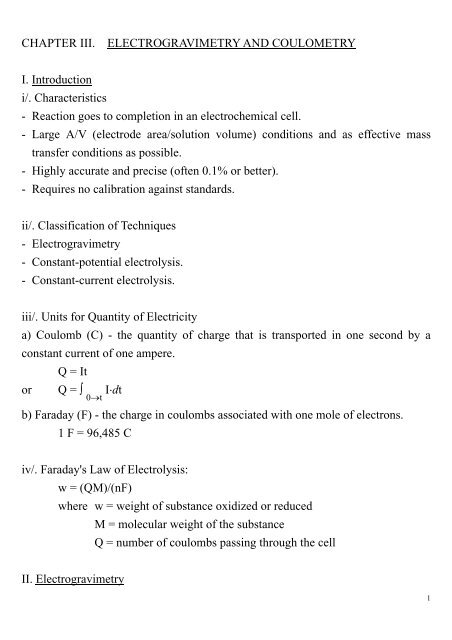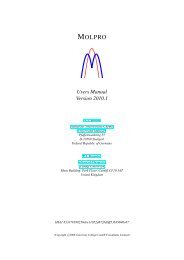CHAPTER III. ELECTROGRAVIMETRY AND COULOMETRY I ...
CHAPTER III. ELECTROGRAVIMETRY AND COULOMETRY I ...
CHAPTER III. ELECTROGRAVIMETRY AND COULOMETRY I ...
Create successful ePaper yourself
Turn your PDF publications into a flip-book with our unique Google optimized e-Paper software.
<strong>CHAPTER</strong> <strong>III</strong>. <strong>ELECTROGRAVIMETRY</strong> <strong>AND</strong> <strong>COULOMETRY</strong><br />
I. Introduction<br />
i/. Characteristics<br />
- Reaction goes to completion in an electrochemical cell.<br />
- Large A/V (electrode area/solution volume) conditions and as effective mass<br />
transfer conditions as possible.<br />
- Highly accurate and precise (often 0.1% or better).<br />
- Requires no calibration against standards.<br />
ii/. Classification of Techniques<br />
- Electrogravimetry<br />
- Constant-potential electrolysis.<br />
- Constant-current electrolysis.<br />
iii/. Units for Quantity of Electricity<br />
a) Coulomb (C) - the quantity of charge that is transported in one second by a<br />
constant current of one ampere.<br />
Q = It<br />
or Q = ∫ I⋅dt 0→t<br />
b) Faraday (F) - the charge in coulombs associated with one mole of electrons.<br />
1 F = 96,485 C<br />
iv/. Faraday's Law of Electrolysis:<br />
w = (QM)/(nF)<br />
where w = weight of substance oxidized or reduced<br />
M = molecular weight of the substance<br />
Q = number of coulombs passing through the cell<br />
II. Electrogravimetry<br />
1
Analyte is quantitatively deposited on a previously weighted electrode.<br />
FIGURE 3-1. “Harris” Fig. 17-5 (p. 379).<br />
Sensitivity is limited by the difficulty in determining the small difference in weight.<br />
<strong>III</strong>. Coulometry<br />
A form of chemical analysis based on counting the electrons used in a reaction.<br />
i/. Potentiostatic Coulometry (Controlled-Potential Coulometry)<br />
e.g., EXAMPLE 3-2. “Harris” Ex. (p. 380).<br />
Current decreases with time owing to:<br />
a) Depletion of sample in the bulk solution.<br />
b) Concentration polarization.<br />
FIGURE 3-3. “Bard” Fig. 10.3.1 (p. 378).<br />
FIGURE 3-4. “Skoog” Fig. 21-1a (p. 519).<br />
The total quantity of electricity Q(t) consumed in the electrolysis is given by the<br />
area under the I-t curve: Q(t) = ∫ I(t)⋅dt.<br />
With a two-electrode cell, the voltage between two electrodes is<br />
E = E(cathode) − E(anode) − IR − overpotentials<br />
As the analyte, say, Cu 2+ , is used up, the current decreases and both the ohmic and<br />
overpotentials decreases in magnitude. If E and E(anode) are constant, then<br />
E(cathode) shifts to more negative values and the solutes more easily reduced than<br />
H + will be electrolyzed.<br />
FIGURE 3-5. “Harris” Fig. 17-7 (p. 380).<br />
To prevent the cathode potential from becoming so negative that unintended ions<br />
are reduced, a three-electrode cell with a potentiostat to control the cathode<br />
potential can be used.<br />
FIGURE 3-6. “Harris” Fig. 17-3 (p. 377).<br />
Working (indicator) electrode - reaction of interest takes place.<br />
2
Reference electrode - maintain a constant potential irrespective of changes in<br />
current.<br />
Counter (auxiliary) electrode - to complete the electrochemical cell but its potential<br />
is rarely of interest.<br />
ii/. Amperostatic Coulometry (Controlled-Current Coulometry)<br />
FIGURE 3-7. “Bard” Fig. 10.4.1 (p. 385).<br />
When applied current < limiting current, current efficiency = 100%<br />
When applied current > limiting current, current efficiency < 100%<br />
The selectivity is poorer than the controlled potential method.<br />
iii/. Coulometric Titrations<br />
Employs a titrant that is electrolytically generated by a constant current, i.e.,<br />
unstable reagents such as Ag 2+ , Cu + , Mn 3+ , and Ti 3+ can be generated and used in a<br />
single vessel.<br />
FIGURE 3-8. “Harris” Fig. 17-9 (p. 382).<br />
Some external means must be used to determine the end-point of the reaction, e.g.,<br />
visual indicators, potentiometry, amperometry, and photometry.<br />
e.g., 2Br − → Br 2 + 2e<br />
H 2 C=CH 2 + Br 2 → H 2 BrCCBrH 2<br />
iv/. Applications<br />
a) Neutralization, Precipitation, and Complex-Formation Titrations<br />
TABLE 3-9. “Skoog” Table 21-1 (p. 529).<br />
b) Oxidation/Reduction Titrations<br />
TABLE 3-10. “Skoog” Table 21-2 (p. 530).<br />
v/. Comparison of Coulometric and Volumetric Titrations<br />
Advantages:<br />
a) Absolute technique needing no standard solution - minimizes errors in<br />
3
preparation and storage of standard solutions.<br />
b) Very small amount of substances can be determined.<br />
c) Substances that are unstable or inconvenient to use can be employed as titrants.<br />
d) Easily automated.<br />
e) Can be performed remotely.<br />
f) More accurate.<br />
4











![Hetero [6+3] Cycloaddition of Fulvenes with N-Alkylidene Glycine ...](https://img.yumpu.com/35423358/1/190x245/hetero-6-3-cycloaddition-of-fulvenes-with-n-alkylidene-glycine-.jpg?quality=85)




